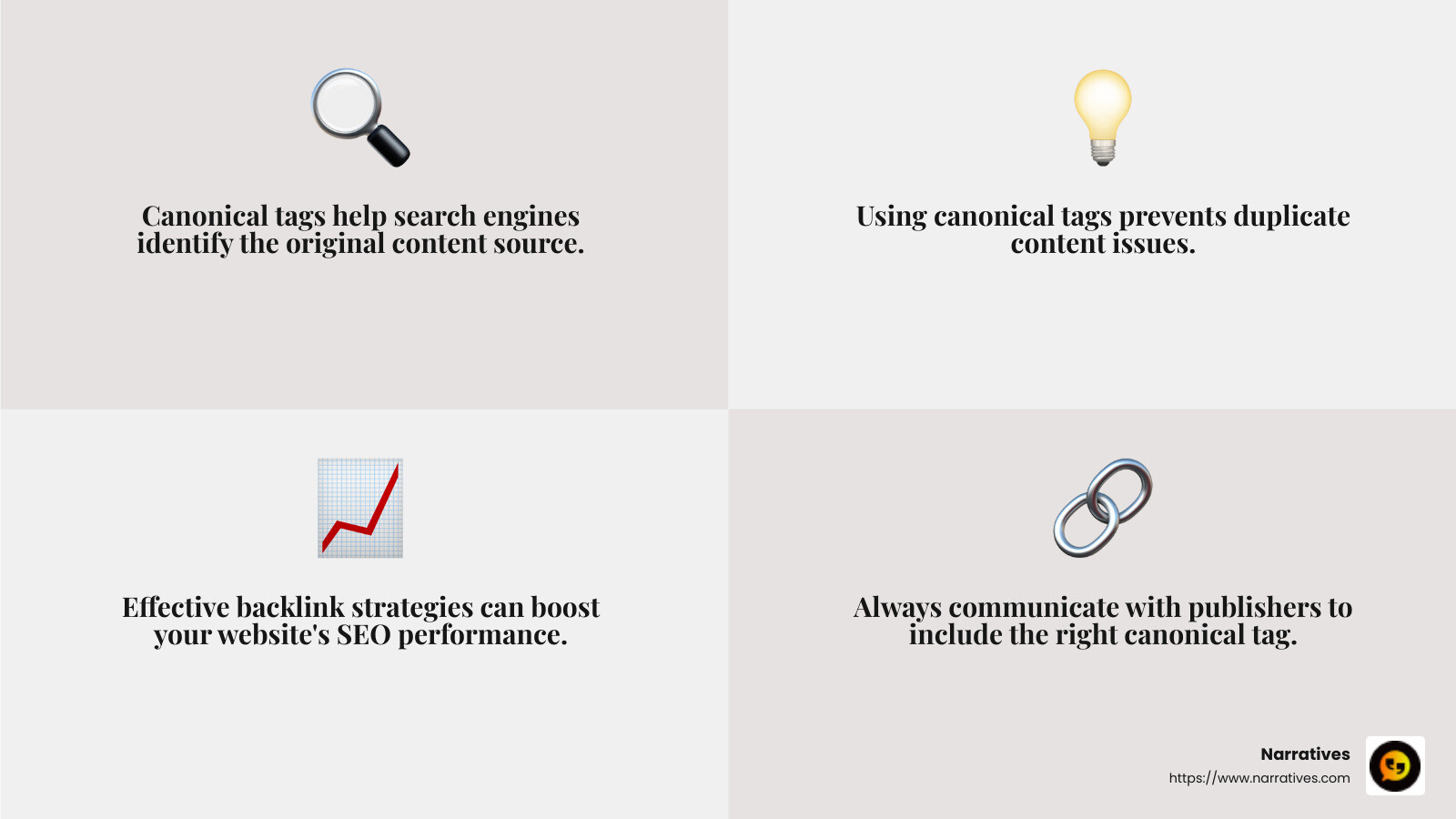Syndicated Content Explained: A Guide to Expanding Your Reach

Syndicated content is a powerful tool for any organization looking to spread its message far and wide without reinventing the wheel. By republishing existing content on third-party platforms, you can increase visibility, boost brand awareness, and improve your authority in your field—all with minimal extra effort.
Here's what you need to know about syndicated content in a nutshell:
- What it is: Republishing content on multiple sites to extend reach.
- Why it matters: Increases audience engagement and builds brand credibility.
- How to do it: Partner with reputable sites for content distribution. Use canonical tags to maintain SEO health.
In a world driven by digital storytelling, content syndication is a key strategy for any brand or organization wanting to make a real impact. This approach allows you to share compelling narratives across various platforms, touching new audiences and amplifying your mission. Non-profits and socially-driven brands that focus on advocacy, diversity, equity, and inclusion (DEI) have a particular edge here—syndicated content can help them tell their stories more effectively, fostering community growth and engagement.
By combining authentic storytelling with strategic syndication, organizations can create significant ripples in the fields of social impact and brand awareness. And at its core, content syndication can turn a single piece of content into multiple opportunities to engage, inform, and inspire.

What is Syndicated Content?
Syndicated content is all about republishing your existing content on other websites. Think of it as giving your content a second life, allowing it to reach new audiences without having to create something brand new each time.
How Does It Work?
When you create a piece of content—like an article, video, or infographic—you can choose to share it on third-party websites. These platforms can be blogs, news sites, or even content networks that cater to your target audience.
Here's a simple breakdown:
Republishing Content: This means taking your original work and allowing it to appear on other sites. It could be the full content or just an excerpt.
Third-Party Websites: These are the platforms that agree to host your content. They benefit by having fresh material for their audience without the effort of creating it themselves.
Content Distribution: This is the process of getting your content out there. It involves selecting the right platforms where your audience hangs out.
Why Use Syndicated Content?
Syndicated content expands your reach. It’s like having multiple billboards in different locations instead of just one. More people get to see your message, and your brand can grow in recognition and authority.
For example, if you’re a non-profit focused on community impact, syndicating your stories on platforms that share your mission can amplify your reach. You can touch more lives and potentially attract more supporters.
The Key to Success
The real magic happens when you choose the right partners for syndication. Look for platforms that align with your goals and values. And always make sure that your original content is credited properly. This not only helps with brand recognition but also keeps your SEO healthy.
By strategically sharing your stories, you can make a bigger impact without extra work. Syndicated content is like planting seeds across a wide field, allowing your message to grow and flourish in ways you might not have imagined.

Next, let's dive deeper into the benefits of using syndicated content for your organization.
Benefits of Syndicated Content
Syndicated content offers numerous advantages that can help your organization thrive. Let's explore three key benefits: brand awareness, SEO performance, and lead generation.
Brand Awareness
Imagine your content as a guide, shining brightly across different platforms. By syndicating it, you're placing that guide in multiple locations, increasing the chances of being seen by new audiences. As your content appears on various websites, more people become familiar with your brand. This wider exposure can lead to increased traffic to your website and potentially more conversions.
Brand engagement is one of the standout benefits. When your content is featured on multiple reputable sites, your brand becomes more recognizable. As noted in the research, "By having your content published on multiple sites, you increase the chances of your content being finded by new audiences."
SEO Performance
Syndicated content can boost your SEO performance in several ways. When your content is shared on reputable sites, it often includes a link back to your website. These backlinks are like votes of confidence from other websites, and search engines take notice.
Good backlinks can improve your site's search engine ranking, making it easier for potential customers to find you. Additionally, when your content is distributed widely, it can establish you as a thought leader in your industry, further enhancing your SEO efforts.
However, it's important to be cautious. Syndicated content isn't the same as duplicate content, but you should still ensure that search engines understand which version is the original. Using canonical tags and proper credits can help you avoid any negative impact on your SEO.
Lead Generation
One of the most exciting benefits of syndicated content is its potential for lead generation. By reaching a broader audience, you increase the likelihood of attracting new leads. Content syndication can funnel these leads into your pipeline, boosting your return on investment.
As mentioned in the research, "Content syndication will boost the return on investment of your content by using it to funnel leads into your pipeline." When done correctly, syndicated content can act as a powerful tool for both marketing and demand generation teams.
By strategically choosing where to syndicate your content, you can target your ideal audience and improve the quality of the leads you generate. This customization ensures that the leads entering your sales funnel are more likely to convert.
With these benefits in mind, it's clear that syndicated content can be a game-changer for your organization. Next, we'll explore how to syndicate content effectively, ensuring you maximize these advantages.
How to Syndicate Content Effectively
Now that we understand the benefits, let's dive into how to syndicate content effectively. We'll explore three main strategies: free syndication, paid syndication, and content partnerships.
Free Syndication
Free syndication is a cost-effective way to expand your reach without spending a dime. This approach involves manually reaching out to other websites or blogs and asking them to republish your content.
Steps to Get Started with Free Syndication:
Identify Potential Partners: Use tools like BuzzSumo or Ahrefs to find websites with similar audiences. Look for phrases like "originally published in" or "republished with permission" in their articles to spot potential partners.
Optimize Your Content: Ensure your content is high-quality and engaging. Use visuals like charts or infographics, as these are often more attractive to publishers. As Sara McGuire from Venngage suggests, "Presenting key statistics, tips and takeaways in a visual format can make your content more attention-grabbing."
Reach Out: Contact the site owners or editors with a personalized pitch highlighting the value your content brings to their audience.
Use Canonical Tags: Ensure the original version of your content is recognized by search engines by using canonical tags. This helps avoid any SEO penalties for duplicate content.
Paid Syndication
Paid syndication is a straightforward way to get your content featured on major publications. Platforms like Outbrain and Taboola allow you to appear as recommended content on high-traffic sites like CNN or BBC.
How Paid Syndication Works:
Set a Budget: Decide how much you're willing to spend. Paid syndication works like PPC campaigns, where you pay for each click your content receives.
Choose the Right Platform: Different platforms offer varying pricing models and targeting options. Research to find the best fit for your goals.
Track and Optimize: Continuously monitor the performance of your campaigns. Adjust targeting options and refine your content based on engagement metrics.
Content Partnerships
Building content partnerships can be a mutually beneficial strategy. By collaborating with organizations or websites that share your audience, you can expand your reach and improve your content offerings.
Building Successful Partnerships:
Find the Right Partners: Look for organizations that align with your values and audience. Use niche publications to ensure you're reaching your target demographic.
Create Valuable Content: Work together to create content that benefits both parties. This could be joint articles, interviews, or co-branded infographics.
Establish Clear Guidelines: Set expectations upfront regarding content use, credits, and backlinks. This ensures a smooth collaboration and maximizes benefits for both parties.
By leveraging these strategies, you can effectively syndicate your content and tap into new audiences. Next, we'll look at best practices to ensure your syndicated content performs optimally.
Best Practices for Syndicated Content
To make the most of syndicated content, follow best practices that improve visibility and protect your SEO. Let's explore three key areas: canonical tags, backlink strategies, and content optimization.
Canonical Tags
Canonical tags are crucial in ensuring search engines recognize the original source of your content. When you syndicate content, the risk of duplicate content issues arises. Google doesn't penalize duplicate content directly but might not rank it well either.
How to Use Canonical Tags:
Communicate with Publishers: Ensure that the third-party sites where your content is syndicated include a canonical tag pointing back to your original article. This signals to search engines which version to index.
Include Source Attribution: Always include a note like, "This article originally appeared on [Your Site]," with a link back to your original content. This aids both readers and search engines.

Backlink Strategies
Backlinks are a powerful tool to boost your SEO performance. When done right, syndicated content can drive valuable referral traffic back to your site.
Effective Backlink Strategies:
Ensure Quality Links: Partner with reputable sites that have high domain authority. This not only improves your SEO but also your brand's credibility.
Incorporate Internal Links: When syndicating content, try to include internal links to other relevant articles on your site. This can increase engagement and keep readers exploring your content.
Monitor Link Quality: Regularly check the backlinks from syndicated content to ensure they are from trustworthy sources and not spammy sites.
Content Optimization
Optimizing your content for syndication involves making it attractive to both publishers and readers. High-quality content is more likely to be picked up by reputable sites.
Tips for Content Optimization:
Use Visuals: Infographics, charts, and images make your content more engaging. As Sara McGuire from Venngage highlights, presenting information visually can significantly increase its appeal.
Focus on Readability: Use simple language and short paragraphs. This makes your content accessible and easy to read, increasing the likelihood of syndication.
Update Regularly: Keep your content fresh and relevant. Regular updates can make your content more appealing to syndication partners looking for timely information.
By adhering to these best practices, your syndicated content can effectively expand your reach while maintaining SEO integrity. Next, we'll tackle some frequently asked questions about syndicated content to address common concerns and misconceptions.
Frequently Asked Questions about Syndicated Content
How does syndicated content affect SEO?
Syndicated content can be a double-edged sword for SEO. On one hand, it can improve your visibility and authority through increased exposure. On the other, it can present challenges like duplicate content issues.
Duplicate Content: When your content appears on multiple websites, search engines may struggle to determine which version to prioritize in search results. This can dilute the visibility of your original content.
Canonical Links: To combat this, use canonical tags. These tags tell search engines which version of the content is the "official" one. By ensuring that syndicated versions link back to your original piece, you can help maintain your site's SEO performance.
What are the risks of content syndication?
While content syndication offers many benefits, it also carries certain risks that need careful management.
SEO Penalties: Although Google doesn’t directly penalize duplicate content, it can affect how your content ranks. If a syndicated version outranks your original, it can lead to decreased visibility for your website.
Brand Reputation: Syndicating your content on low-quality or irrelevant sites can damage your brand's reputation. It's crucial to choose syndication partners wisely to ensure your content is associated with reputable platforms.
How can I find syndication partners?
Finding the right partners is crucial for successful content syndication. Here are some strategies to consider:
Content Syndication Platforms: Platforms like Medium and LinkedIn allow for easy content republishing. These platforms prioritize native content, which can boost engagement and visibility.
Niche Publications: Look for industry-specific publications that cater to your target audience. These can be more effective than general platforms because they align closely with your brand's focus.
To identify potential partners, research your competitors' syndication efforts. Use keyword monitoring tools to track where their content is being syndicated. This can reveal opportunities for partnerships with sites that already value similar content.
By understanding these aspects of syndicated content, you can expand your reach while safeguarding your SEO and brand reputation.
Conclusion
Syndicated content is a powerful tool for expanding your reach and amplifying your message. At Narratives, we understand the unique challenges faced by non-profits and purpose-driven organizations. Our mission is to lift underrepresented voices through compelling storytelling, helping you share impactful stories that inspire action and build trust.
Non-Profit Storytelling: We specialize in creating emotionally resonant video and multimedia content that highlights the incredible work being done by non-profits. By sharing these stories through syndication, we ensure that your message reaches a wider audience, increasing visibility and support for your cause.
Community Impact: Effective content syndication not only boosts brand awareness but also drives community engagement. By partnering with reputable platforms and publications, we help you connect with audiences who are passionate about making a difference. This approach fosters a sense of community and encourages collective action towards positive change.
As we continue to support non-profits in their storytelling journey, we invite you to learn more about how our services can help your organization grow. Explore our digital storytelling services and find how we can amplify your impact through strategic content syndication.
By embracing the power of syndicated content, you can ensure that your important stories reach those who need to hear them the most. Together, we can create a more informed, empathetic, and connected world.


